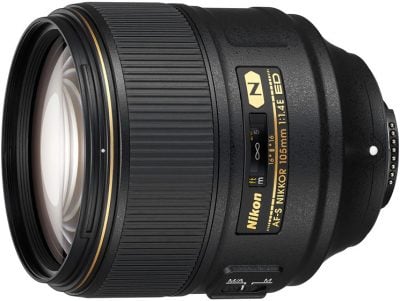Nikon 105mm f1.4E review
-
-
Written by Thomas
Quality
Testing: Longitudinal Chromatic Aberration and focus shift
Lenses with focal ratios of f2.8 or larger are often prone to longitudinal color aberrations (loCA, a.k.a. “axial color” or “bokeh CA”). These show up as magenta coloration in the foreground and greenish hues in the background and are not easily corrected in post-processing. The Nikon shows some loCA at f1.4. The effect is a little stronger at f2.0 but by f5.6 it is gone. The test also revealed that there is no focus shift to speak of at normal distances. But when you shoot around 1m there is some focus shift: the center becomes a little less sharp when you stop down before the deeper dof catches up with the focus shift at around f4.0.
Nikon 105mm f1.4E ED Longitudinal Chromatic Aberration (loCA)
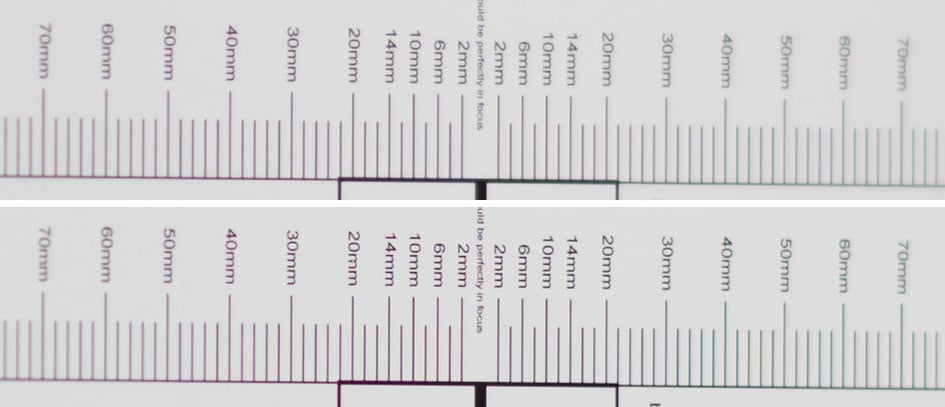
100% crop, 105mm, f1.4 (top) and f2.0 (bottom), left = foreground, right = background
But to put this in perspective, the Nikon 105/2.0D DC shows clearly worse loCA:
Nikon 105mm f2.0D DC Longitudinal Chromatic Aberration (loCA)
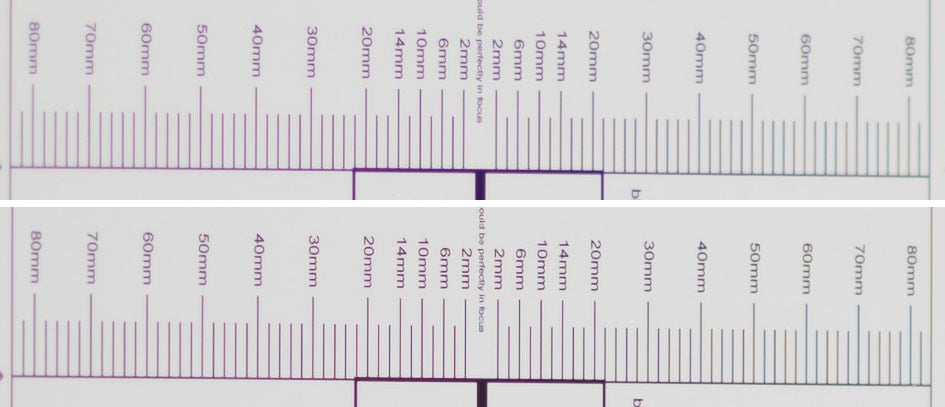
100% crop, 105mm, f2.0 (top) and f2.8 (bottom), left = foreground, right = background
The Samyang 135/2.0 ED UMC is better behaved:
Samyang 135mm f2.0 ED UMC Longitudinal Chromatic Aberration (loCA)
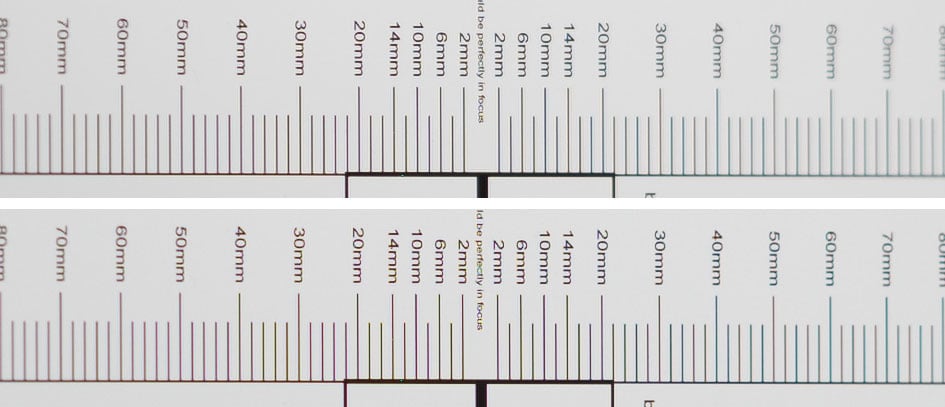
100% crop, 135mm, f2.0 (top) and f2.8 (bottom), left = foreground, right = background
Sharpness and contrast
Let’s have a look at the theoretical performance of the Nikon first and compare it to the performance of the DC Nikkor 105mm f2.0D:
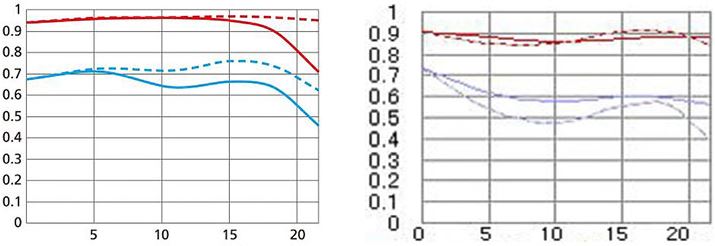
Above: MTF Nikon 105/1.4E at f1.4 (left), Nikon 105/2.0D DC at f2.0 (right)
These charts show the lens-performance of both lenses at their largest aperture which is f1.4 for the Nikon 105/1.4E ED and f2.0 for the Nikon 105/2.0D DC so it’s not really a fair apples-to-apples comparison. To read these charts you need to know that higher values are better and the closer the line-pairs are together the less astigmatism (= resolution depends on the orientation of the test-pattern) the lens has. The x-axis displays the distance from the optical axis (=center of the sensor) in mm. I’ll show you the real-life performance at 4 mm (center), 13 mm (DX-corner), and 20 mm (FX-corner) on a D810.
From the charts, overall contrast from the new Nikon should be very high indeed even at f1.4. It’s higher than from the DC Nikkor at f2.0 in the first 18mm with a slight dip in the outer 2 mm where some astigmatism develops. The blue 30 pl/mm line(s) also indicates a fairly good resolution of the new Nikon at f1.4 with only little loss in the corners. The DC Nikkor is also quite sharp in the exact center then drops slightly in the first 5mm of the image circle but keeps up pretty well into the corners of a full-frame sensor. This is an indicator why the DC Nikkor still has a strong following, it must have been one of the sharpest lenses around when it was released. But when comparing both lenses don’t forget this is at f2.0. Overall this looks quite promising for Nikon’s new lens. Let’s see how this theoretical performance translates into real life results in the sharpness test based on Siemens-stars.
What follows are near-center results (first column) followed by APS-C/DX-corner results and FF/FX-corner results on a D810. Processing was done in Lightroom 6.6 from RAW at Camera Standard settings. Noise-reduction is set to 0, sharpening to 35/0.5/36/10, with no extra tone, color, or saturation-adjustment. White-balance was adjusted to a neutral white and I did some exposure compensation to make the brightness of all crops match. So you will not see light fall-off in the corners. CA-removal is ON.
The following are all 100% crops!
Nikon 105/1.4E ED shot with Nikon D810; 100% crop from center, DX-corner, FX-corner

Above: 105mm, f1.4

Above: 105mm, f2.0

Above: 105mm, f2.8

Above: 105mm, f4.0

Above: 105mm, f5.6

Above: 105mm, f8.0

Above: 105mm, f11

Above: 105mm, f16
These 100% crops directly from a 36MP D810 sensor shows a very good performance of this lens right from f1.4 with only a little softening towards the corners of a full-frame sensor. All crops for an aperture were taken from the same shot as there is no discernible field curvature at this distance. Diffraction clearly sets in at f11. Distortion is a bit pin-cushion.
The following comparison is at f2.0 and shows the Nikon 105/1.4E ED (1st row), the Nikon AF 105/2.0D DC (2nd row), and the Samyang 135/2.0 ED UMC (last row):

Above: Nikon 105/1.4E ED at 105mm, f2.0

Above: Nikon AF 105/2.0D DC at 105mm, f2.0

Above: Samyang 135/2.0 ED UMC at 135mm, f2.0
The DC Nikkor is clearly the softest of the three at 4mm off center. Like the MTF curve indicates it’s indeed a little sharper dead-center but still does not reach the overall contrast or resolution of the new Nikon or the Samyang. With the Samyang having the advantage of showing a little less spherical aberrations in the center over the new Nikon. At the DX-corner all three lenses perform pretty similar. And at the FX-corner both Nikon lenses get a bit softer than the Samyang. Regarding field curvature: While the Samyang needed a bit of focus optimization indicating a slightly curved field the DC Nikkor didn’t need this.
Following is a direct comparison of the Nikon (1st row) to the Zeiss Otus 85/1.4 (2nd row) at f1.4:

Above: Nikon 105/1.4E ED at 105mm, f1.4

Above: Zeiss Otus 85/1.4 at 105mm, f1.4
The direct comparison to the Zeiss Otus at f1.4 reveals that Nikon really has done a very good job when they designed their new lens: In the center it is as sharp as the Otus perhaps even a bit ahead if you accept a little loCA and at the DX-corner and the FX-corner it’s just a tad behind.
Performance at large distances
This is a series of test-shots of a landscape dubbed the “Unremarkables” where you can measure distances in km, not meter. I use this scene to show you how the lenses perform when almost everything is at infinity. I set White Balance to a standard daylight value to make them comparable across lenses shot at the same day and also try to make exposure comparable. There’s no tinkering with vignette-control so you see it here as it is produced by the lens. Focus was manually acquired at the largest aperture in live-view and not changed for other apertures.
You can click on the main image or the crops to access the respective large original or you use the links beneath the main image. Please respect our copyright and only use those images for personal use.
The main image shows the complete scene at maximum aperture to give you an impression of the angle of view and to judge vignetting. This is followed by one row of 100% crops from f1.4 to f11 each from the middle, the DX-corner and the right FX-corner.
Nikon 105/1.4E ED shot with Nikon D810
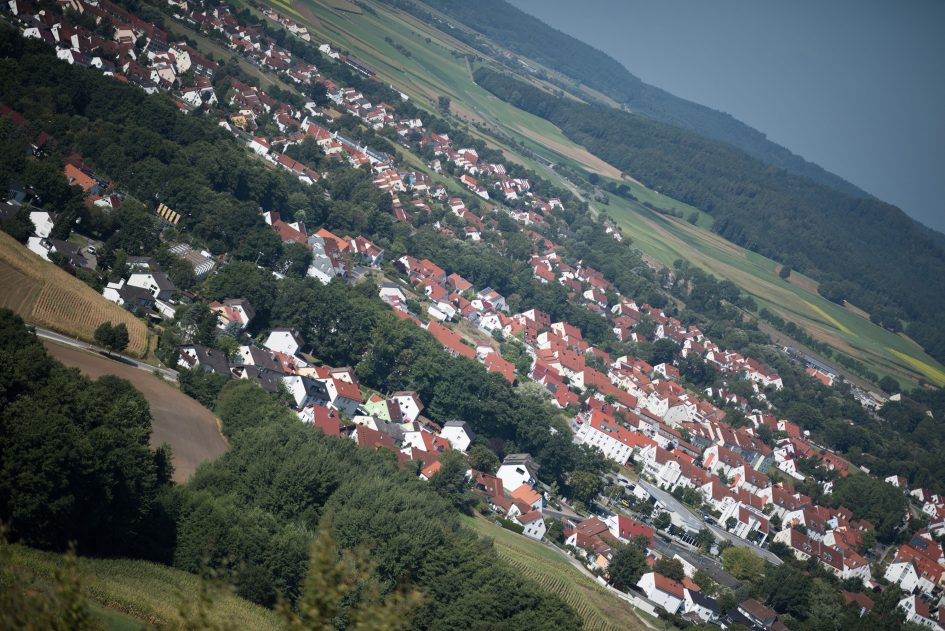
Above: 105mm, f1.4; also available at f2.0, f2.8, f4.0, f5.6, f8.0, f11, f16

Above: 105mm, f1.4

Above: 105mm, f2.0

Above: 105mm, f2.8

Above: 105mm, f4.0

Above: 105mm, f5.6

Above: 105mm, f8.0

Above: 105mm, f11
Performance at long distances shows that this lens is very good even wide open across the sensor. There’s a little haloing of bright areas which can be effectively reduced by stopping down to f2.0. The amount of vignetting seems pretty moderate for an f1.4 lens. Stop down to f2.8 to get excellent clarity across the sensor and very low light fall-off.
I shot the same scene within minutes with the Nikon 105/2.0 D DC and the Samyang 135/2.0 for comparison at f2.0. As I always take the diagonal that produces the best results you have to make do with some alternatingly skewed crops:

Above: Nikon 105/1.4E ED at f2.0

Above: Nikon 105/2.0D DC at f2.0; also available at f2.8, f4.0, f5.6, f8.0, f11, f16

Above: Samyang 135/2.0 ED UMC at f2.0; also available at f2.8, f4.0, f5.6, f8.0, f11, f16
The DC Nikkor suffers from some reduced contrast in the DX image-circle with magenta CAs but produces an FX-corner that is slightly better than from the new Nikon 105/1.4E. That is because the new Nikon develops at little field-curvature at infinity while the DC Nikkor stays flat. Looking at the Samyang and taking into account that it benefits from the 30% larger magnification I’d say that the new Nikon produces the slightly sharper center. But in the DX-corner and the FX-corner the Samyang pulls ahead.
And here’s the Zeiss 85/1.4 Otus also shot at the same time for comparison at f1.4:

Above: Nikon 105/1.4E ED at f1.4

Above: Zeiss Otus 85/1.4 at f1.4
The shot from the Zeiss Otus is also available at f2.0, f2.8, f4.0, f5.6, f8.0, f11, f16.
Again you have to bear the different magnification in mind but all-in-all I’d say that both lenses look almost identical in this shot.
Rendering of point-light sources at night-shots
Night-shots pose a different challenge for lenses as the contrast is even higher than under bright sun and point-light sources can reveal some weaknesses such as coma, haloing and color-aberrations that do not show up as prominently in other test-shots. The 100% crops below the main image show the effect of coma in the FX-corner of the Nikon and the competition at various apertures:
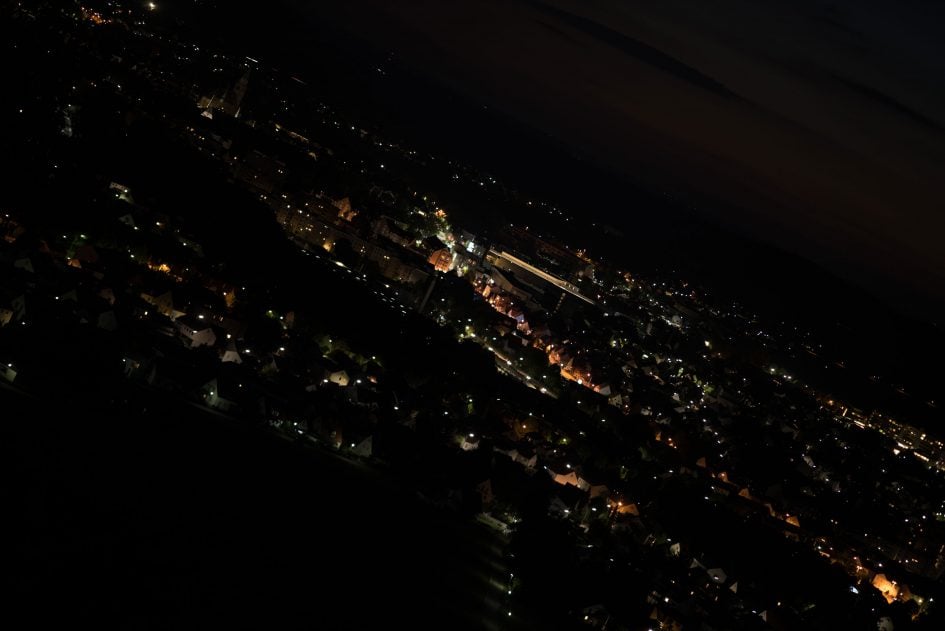
Above: Nikon 105mm f1.4E ED at f1.4; also available at f2.0, f2.8, f4.0, f5.6, f8.0

Above: Nikon 105mm f1.4E ED; FX-corner at f1.4 (left), f2.0 (middle), f2.8 (right)

Above: Nikon 105mm f2.0D DC at neutral; FX-corner at f2.0 (left), f2.8 (middle), f4.0 (right)

Above: Samyang 135mm f2.0 ED UMC; FX-corner at f2.0 (left), f2.8 (middle), f4.0 (right)

Above: Zeiss 85mm f1.4 Otus; FX-corner at f1.4 (left), f2.0 (middle), f2.8 (right)
The new Nikon has only little coma comparable to the Zeiss Otus but is still bested by the DC Nikkor and the Samyang at f2.0. The latter has practically no coma at all.
Rendering of out-of-focus point-light sources and Bokeh
This test is for the rendering of point-light sources in an out-of-focus background. The circle of confusion that is produced by this test is pretty indicative of Bokeh performance (in the background) and light fall-off. Ideally the out-of-focus image of the point-light is evenly lit and perfectly circular, with no “onion-rings”, and without coloration. Large aperture lenses normally produce an effect known as “cat’s eye” the further away from the optical axis the point-light is projected. This is due to optical vignetting in the lens barrel when light enters the lens from an angle.
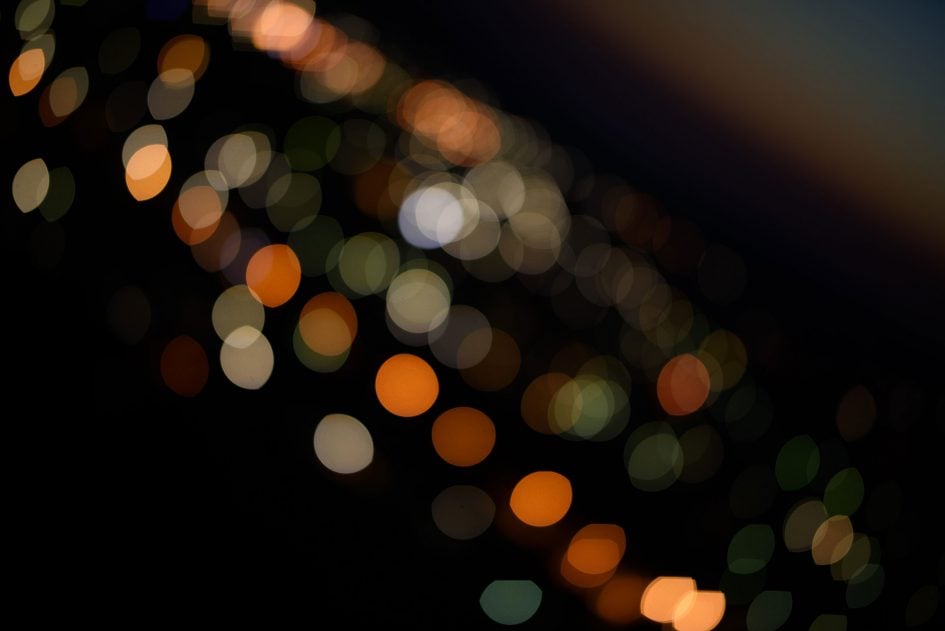
Above: Nikon 105/1.4E ED at f1.4; also available at f2.0, f2.8, f4.0, f5.6, 8.0

Above: Nikon 105/1.4E ED; 50% crops from center, DX-corner, FX-corner
As the 50% crops above show: The Nikon 105/1.4 produces very big Bokeh balls when used wide open. It exhibits no onion rings and the light-distribution across the circle is very even. Outlining is also moderate but shows some green from loCA and increases in the FX-corner. There’s also a strong cat’s eye effect which reduces the size of the Bokeh balls quite seriously and may generate some nervousness in out-of-focus areas in the corners of an image. There is also some prominent clipping from the mirror-box at the top and bottom of the image. Let’s see how the competition compares:

Above: Nikon 105/2.0D DC at neutral; 50% crops from center, DX-corner, FX-corner

Above: Samyang 135/2.0 ED UMC; 50% crops from center, DX-corner, FX-corner

Above: Zeiss Otus 85/1.4; 50% crops from center, DX-corner, FX-corner
The shot from the Nikon 105/2.0D DC is also available at f2.8, f4.0, f5.6, f8.0, from the Samyang 135/2.0 ED UMC at f2.8, f4.0, f5.6, f8.0, and from the Zeiss Otus 85/1.4 at f2.0, f2.8, f4.0, f5.6, f8.0.
There you have it: The new Nikon 105/1.4E has the largest entrance pupil from the lenses tested here and thus produces the biggest Bokeh balls in the center. 2nd place goes to the Samyang which compensates its smaller focal ratio partially by the 30% larger magnification. The Zeiss Otus occupies 3rd place and the DC Nikkor 4th. Towards the corners of the sensor the Samyang develops the weakest cat’s eye effect, while the others are pretty similar. Clipping occurs on the DC Nikkor (as well as the new Nikon) and the Zeiss Otus while the Samyang only shows it at the extreme bottom of the image. All four lenses are free of clipping artifacts at f2.8. Regarding loCA: both the Zeiss and the Samyang are free of green outlining, the new Nikon shows mild green outlining and the DC Nikkor is worst. Inside the circles of confusion the Samyang has the smoothest appearance followed by both Nikkors while the Zeiss Otus shows some slight onion rings.
Now let’s see how this analysis of out-of-focus point-light sources translates into Bokeh-performance shooting a bookshelf:
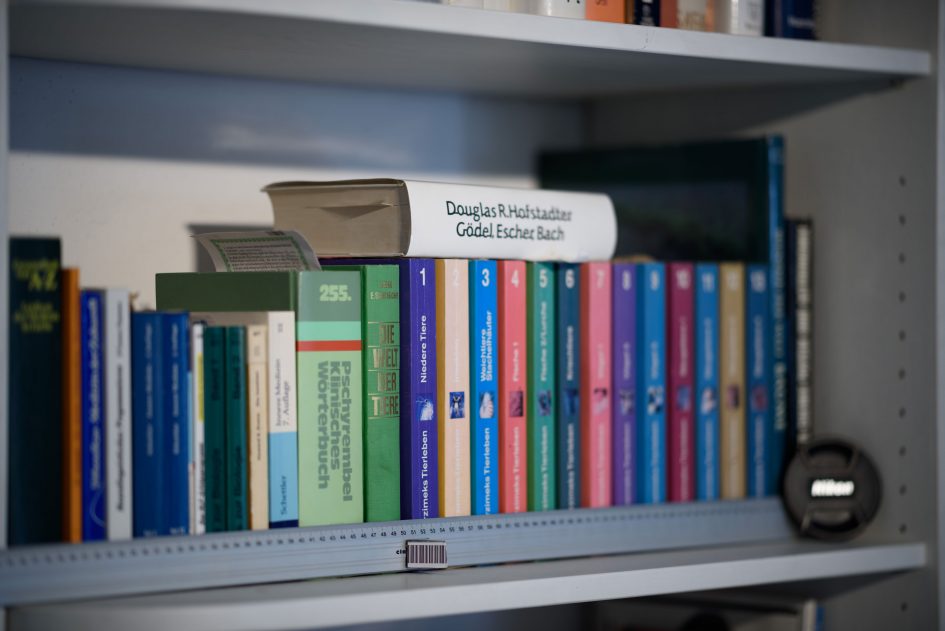
Above: Nikon 105/1.4E ED at f1.4; also available at f2.0, f2.8, f4.0, f5.6, f8.0

Above: Nikon 105/1.4E ED; 50% crops from foreground, middle-ground, background
The (less important) foreground is a bit nervous. The middle ground fades nicely into blur but shows some color artifacts from loCA although I’ve seen worse from other large aperture lenses. And the background looks good. Let’s see how the other lenses compare, especially the Nikon 105/2.0D DC at different Defocus-image Control settings from neutral to 4R:

Above: Nikon 105/2.0D DC at neutral; 50% crops from foreground, middle-ground, background

Above: Nikon 105/2.0D DC at 2R; 50% crops from foreground, middle-ground, background

Above: Nikon 105/2.0D DC at 2.8R; 50% crops from foreground, middle-ground, background

Above: Nikon 105/2.0D DC at 4R; 50% crops from foreground, middle-ground, background
At neutral DC settings the Nikon 105/2.0D DC has an unpleasing Bokeh: nervous in the foreground, colored from loCA in the middle-ground, and with outlining and ghosting in the background. The results from the Nikon 105/1.4E are much more desirable. Setting the Defocus-image Control to 2R reduces the loCA in the middle-ground somewhat and softens the background visibly which makes this lens look much more like the 105/1.4E (at f1.4 mind you!). But the foreground becomes harsher. It is worth mentioning that the overall contrast at the focal plane is not (yet) reduced. With DC at 2.8R and 4R the 105/2.0D DC suffers a general reduction in contrast from a veiling glare and the foreground becomes progressively uglier. Looking at the middle-ground the characteristic of the blur changes: The letters become sharper but with a much reduced contrast against the white paper. It looks like a soft filter attached to the lens. The background is now very soft and creamier than from the 105/1.4E. If you turn the DC-ring in the other direction (for values of 2F up to and above 5.6F) the effect is kind of reversed: The foreground becomes progressively blurrier/hazier and the background at first more nervous and then sharper. For a full set of examples on this special effect head over to my Nikon 105mm f2.0D DC sample images.
Let’s see how the Nikon 105/1.4E fares against lenses at other focal lengths at their respective maximum aperture:

Above: Nikon 105/1.4E ED; 50% crops from foreground, middle-ground, background

Above: Samyang 135/2.0 ED UMC; 50% crops from foreground, middle-ground, background

Above: Zeiss Otus 85/1.4; 50% crops from foreground, middle-ground, background

Above: Nikon 85/1.4G; 50% crops from foreground, middle-ground, background
The shot from the Samyang is also available at f2.8, f4.0, f5.6, f8.0, from the Zeiss Otus at f2.0, f2.8, f4.0, f5.6, from the Nikon 85/1.4G at f2.0, f2.8, f4.0, f5.6, f8.0.
In the foreground the Samyang and the Nikon 85/1.4G lose due to their nervous rendering. In the middle-ground both the Samyang and the Zeiss display almost no color artifacts from loCA which is preferable over the slightly greenish production of the Nikon 105/1.4E. Although to be fair: I’ve seen worse from other large aperture lenses, see e. g. the DC Nikkor or the Nikon 85/1.4G above. The Zeiss has the added advantage in the middle-ground of blurring faster behind the plane of sharpest focus. In the background these three lenses show a very satisfying creamy Bokeh and it’s hard to favor one over the other. All-in-all the Samyang, Zeiss and Nikon 105/1.4E produce very good Bokeh with a slight advantage for the Zeiss Otus. And all three lenses look better than the Nikon 105/2.0D DC at neutral or the Nikon 85/1.4G. But at higher DC settings the DC Nikkor can produce stronger softening effects than the “normal” lenses.
Well, bookshelves give a good indication of Bokeh performance: the test-shots are 100% reproducible and the contrast of the books let’s one see imperfections easier. But in the end Bokeh is not for shooting books, it would be called “Bookeh” then, wouldn’t it? So let’s turn to a situation where Bokeh really plays a decisive role: portraiture. Fortunately I managed to get my model sit still long enough to inflict shooting 5 lenses on her. You wouldn’t imagine how much of a pain that was – for her! But now I can proudly present a comprehensive comparable portrait series with all the close-up detail. All shots were taken within minutes of each other. I developed them to the same white-balance and tried to match exposure as best as possible.

Above: Nikon 105/1.4E ED at f1.4; also available at f2.0, f2.8

Above: Nikon 105/1.4E ED at f1.4; 50% crops

Above: Nikon 105/2.0D DC at neutral, f2.0; 50% crops

Above: Nikon 105/2.0D DC at 2.8R, f2.0; 50% crops

Above: Samyang 135/2.0 ED UMC at f2.0; 50% crops

Above: Zeiss 135/2.0 Apo Sonnar at f2.0; 50% crops

Above: Zeiss Otus 85/1.4 at f1.4; 50% crops
All things look pretty similar except for the DC Nikkor which develops a strong softening effect with DC set to 2.8R. Perhaps a setting of 2R would have been more appropriate in this case. With DC at neutral the lens shares the last place regarding background blur (right crop) with the Zeiss 135/2.0. In the transition zone (left crop) the new Nikon 105/1.4E is the smoothest followed by the Samyang and the Zeiss Otus but the differences are not that big. Looking at the full pictures (click on the crops) I actually like the Bokeh rendering of the new Nikon best.
Flare/ghosting
Catching a strong light-source shining directly into the lens is always a risky business. It could produce strange colorful ghosts-images or reduce contrast considerably through flare and glare. The appearance of flare and ghosting depends on factors like the aperture and the angle of the light hitting the lens. So to judge the proclivity of the Tamron for these artifacts I went through a series of well calculated shots against a strong light source to provoke glare and ghosting. The lens hood was attached in all of these tests.
The results are good. With the light outside the image-frame there’s not much to fear. Have the light inside the frame and there are some artifacts – although to be fair: the test-conditions are quite challenging. Following are two of the more extreme effects:
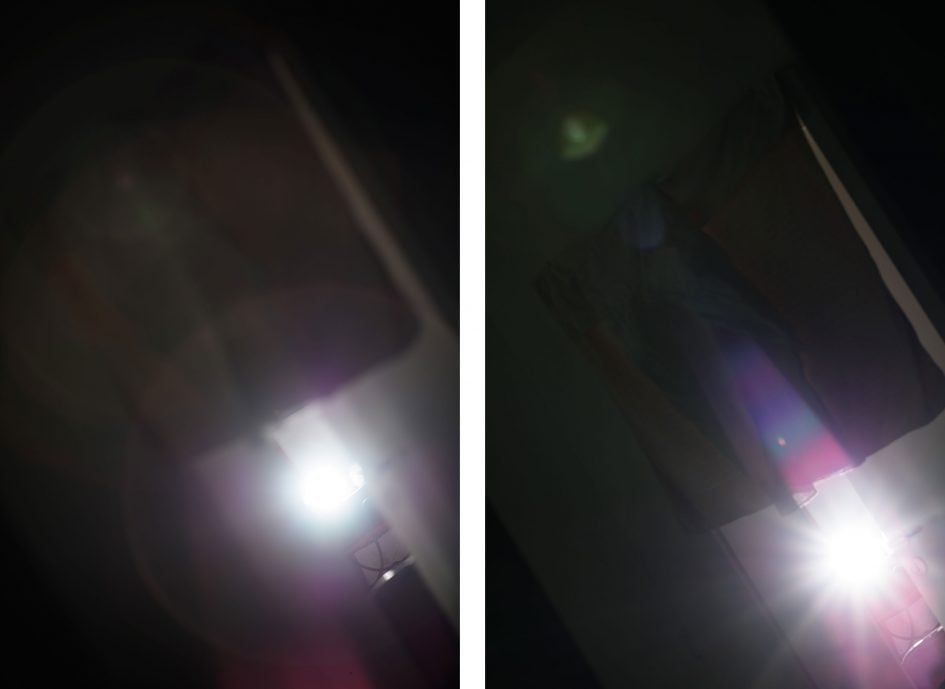
Above: Flare and ghosting. Strong light hitting the Nikon 105/1.4E ED at f1.4 (left), f8.0 (right)




